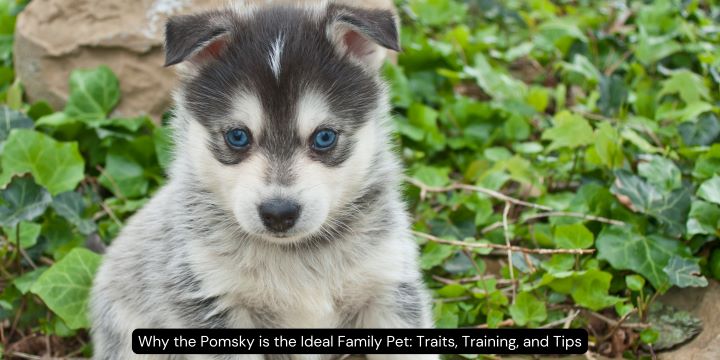Key Takeaways
- Understand why the Pomsky is a perfect fit for families.
- Learn about the traits that make the Pomsky unique.
- Discover essential training and care tips for Pomsky owners.
Table of Contents
- Introduction
- Why Choose a Pomsky?
- Pomsky Traits and Characteristics
- Training Tips for Your Pomsky
- Caring for Your Pomsky
- Common Health Issues
- Activity and Exercise Needs
- Conclusion
Introduction
Pomskies, a mix of Pomeranian and Siberian Husky, have gained popularity with pet enthusiasts. Their unique blend of small size and Husky-like appearance makes them an attractive choice for many families. If you’ve been searching for Pomsky puppies for sale, you’ll appreciate the fascinating traits this hybrid has to offer. This article delves into why Pomskies might be the ideal pet for your home, their characteristics, and how to properly care for and train them. By the end of this guide, you’ll have a comprehensive understanding of what makes the Pomsky a delightful addition to any family.
Why Choose a Pomsky?
Choosing the right family pet is a crucial decision. Pomskies are known for their friendly and playful disposition, which makes them great companions for children and adults alike. Their joyful nature ensures that they fit in seamlessly with various household dynamics. Moreover, their manageable size and adaptability to different living environments—from apartments to houses with backyards—add to their appeal. According to a report by the ASPCA, smaller breeds like the Pomsky are easier to manage and can be an excellent choice for urban living. Their moderate exercise needs mean that even busy families can find time to meet their activity requirements, making them both a practical and lovable option.
Pomsky Traits and Characteristics
Pomsky inherits endearing traits from both parents. Typically, Pomskies have a thick double coat that can take after either parent’s coloration and markings, providing a unique appearance that varies widely among individuals. Their eyes are often striking, frequently exhibiting the mesmerizing blue hue of a Husky, which adds an extra layer of charm and allure. They are also known for their intelligence and affectionate nature, making them easy to bond with and train. A well-trained Pomsky can become very attuned to their owner’s feelings and commands, creating a harmonious living situation. To read more about the fascinating genetics behind Pomsky traits, check out this article from the AKC. With their spirited behavior and gentle demeanor, these dogs bring great joy to any household.
Training Tips for Your Pomsky
Training your Pomsky requires consistency and patience due to their high intelligence and an occasional stubborn streak. Positive reinforcement techniques work best, encouraging desired behaviors through rewards and praise rather than punishment. Start with basic commands such as sit, stay, and recall before moving on to more complex tasks. These foundational commands build a framework for further training and help establish the owner as the leader. Crate training can also benefit housebreaking and provide your Pomsky with a safe and secure space. Make the crate inviting and comfortable, and never use it as punishment.
Basic Commands
Begin with simple commands such as “sit,” “stay,” and “come.” Consistent practice will help your Pomsky learn faster. Use treats and verbal praises to reinforce good behaviors. Repetition and patience are essential, as Pomskies, like all dogs, learn best through consistent and positive reinforcement.
Crate Training
Crate training can be efficient for Pomskies. It provides a safe space for them and aids in housebreaking. Make sure the crate is comfortable and treated as a positive environment. Introduce the crate gradually and encourage your Pomsky to spend short periods inside with treats and toys to make it a place they associate with calm and safety.
Caring for Your Pomsky
Proper care for a Pomsky involves regular grooming to maintain their beautiful coat. A weekly brushing session can help manage shedding and keep their fur clean. This also acts as a bonding experience and a chance to inspect for skin problems or parasites. In addition, it is essential to trim their nails every month and brush their teeth regularly to avoid dental issues. Ensuring a balanced diet and regular vet check-ups will keep your Pomsky healthy and happy. Their diet should include high-quality commercial dog food and occasional treats can be rewarded during training sessions.
Grooming
Regular grooming is essential to keeping your Pomsky’s coat in top condition. Invest in a good-quality brush and grooming tools. The undercoat is handy during shedding seasons, making brushing necessary to avoid matting and promote healthy skin and fur.
Diet and Nutrition
Your Pomsky’s diet should be well-balanced, consisting of high-quality dog food that meets their nutritional needs. Avoid human or low-grade dog food, which may lead to health issues. Consult your vet for specific dietary recommendations, especially if your Pomsky has allergies or sensitivities.
Common Health Issues
Like other breeds, Pomskies can have specific health concerns like hip dysplasia and dental issues. It’s essential to be aware of these potential risks and take preventive measures. Regular exercise and a nutrient-rich diet can go a long way in maintaining your Pomsky’s health. Regular vet check-ups will help in early diagnosis and management of potential issues, ensuring that health concerns are promptly addressed. For a deeper dive into general canine health, refer to this guide from WebMD.
Hip Dysplasia
Pomskies often experience hip dysplasia, which can cause pain and problems with movement. Regular visits to the veterinarian can help detect this early and control it efficiently. Eating a balanced diet and engaging in regular physical activity can help reduce the risk of inheriting this genetic condition.
Dental Issues
Dental problems can arise if proper oral hygiene is not maintained. Regular brushing and occasional dental chews can help prevent these issues. Dental infections can lead to more serious conditions if left untreated, so regular oral check-ups are recommended.
Activity and Exercise Needs
Pomskies must stay active and exercise regularly to remain healthy and content. Daily walks and playtime in a secure yard or park are ideal. A well-exercised Pomsky is less likely to show behavioral issues related to boredom. Engaging in toys and activities can enhance their cognitive development and prevent boredom, thus decreasing the chances of engaging in destructive behaviors. Keeping your mind active is just as important as staying physically fit, so agility training and puzzle toys are great for keeping you engaged.
Daily Walks
Plan for at least one long walk or two shorter walks each day. This provides physical exercise and mental stimulation. The route should vary to expose your Pomsky to different environments and scents, keeping their minds active and curious.
Interactive Play
Engage your Pomsky with interactive toys and activities that challenge their mind and body. These can include fetch, puzzle toys, or agility exercises. Interactive playtime can also serve as an opportunity to train and reinforce good behaviors while providing the stimulation that Pomskies require to stay happy and healthy.
Conclusion
In conclusion, the Pomsky stands out as an ideal family pet for those looking for a smaller breed with the characteristics of a Siberian Husky. Their friendly nature, adaptability, and intelligence make them a well-rounded addition to any family. By following the tips outlined above, you can ensure a happy and fulfilling life for your Pomsky. Whether through consistent training, regular grooming, or proper exercise and nutrition, the joy a Pomsky brings to your household is undoubtedly worth the effort.

